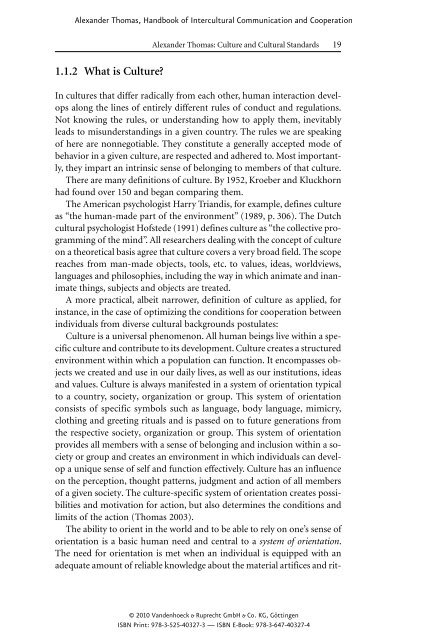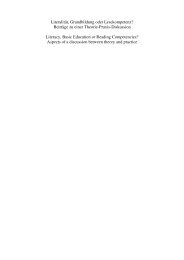Handbook of Intercultural Communication and ... - E-cademic
Handbook of Intercultural Communication and ... - E-cademic
Handbook of Intercultural Communication and ... - E-cademic
You also want an ePaper? Increase the reach of your titles
YUMPU automatically turns print PDFs into web optimized ePapers that Google loves.
Alex<strong>and</strong>er Thomas, <strong>H<strong>and</strong>book</strong> <strong>of</strong> <strong>Intercultural</strong> <strong>Communication</strong> <strong>and</strong> Cooperation<br />
1.1.2 What is Culture?<br />
Alex<strong>and</strong>er Thomas: Culture <strong>and</strong> Cultural St<strong>and</strong>ards 19<br />
In cultures that differ radically from each other, human interaction develops<br />
along the lines <strong>of</strong> entirely different rules <strong>of</strong> conduct <strong>and</strong> regulations.<br />
Not knowing the rules, or underst<strong>and</strong>ing how to apply them, inevitably<br />
leads to misunderst<strong>and</strong>ings in a given country. The rules we are speaking<br />
<strong>of</strong> here are nonnegotiable. They constitute a generally accepted mode <strong>of</strong><br />
behavior in a given culture, are respected <strong>and</strong> adhered to. Most importantly,<br />
they impart an intrinsic sense <strong>of</strong> belonging to members <strong>of</strong> that culture.<br />
There are many definitions <strong>of</strong> culture. By 1952, Kroeber <strong>and</strong> Kluckhorn<br />
had found over 150 <strong>and</strong> began comparing them.<br />
The American psychologist Harry Tri<strong>and</strong>is, for example, defines culture<br />
as “the human-made part <strong>of</strong> the environment” (1989, p. 306). The Dutch<br />
cultural psychologist H<strong>of</strong>stede (1991) defines culture as “the collective programming<br />
<strong>of</strong> the mind”. All researchers dealing with the concept <strong>of</strong> culture<br />
on a theoretical basis agree that culture covers a very broad field. The scope<br />
reaches from man-made objects, tools, etc. to values, ideas, worldviews,<br />
languages <strong>and</strong> philosophies, including the way in which animate <strong>and</strong> inanimate<br />
things, subjects <strong>and</strong> objects are treated.<br />
A more practical, albeit narrower, definition <strong>of</strong> culture as applied, for<br />
instance, in the case <strong>of</strong> optimizing the conditions for cooperation between<br />
individuals from diverse cultural backgrounds postulates:<br />
Culture is a universal phenomenon. All human beings live within a specific<br />
culture <strong>and</strong> contribute to its development. Culture creates a structured<br />
environment within which a population can function. It encompasses objects<br />
we created <strong>and</strong> use in our daily lives, as well as our institutions, ideas<br />
<strong>and</strong> values. Culture is always manifested in a system <strong>of</strong> orientation typical<br />
to a country, society, organization or group. This system <strong>of</strong> orientation<br />
consists <strong>of</strong> specific symbols such as language, body language, mimicry,<br />
clothing <strong>and</strong> greeting rituals <strong>and</strong> is passed on to future generations from<br />
the respective society, organization or group. This system <strong>of</strong> orientation<br />
provides all members with a sense <strong>of</strong> belonging <strong>and</strong> inclusion within a society<br />
or group <strong>and</strong> creates an environment in which individuals can develop<br />
a unique sense <strong>of</strong> self <strong>and</strong> function effectively. Culture has an influence<br />
on the perception, thought patterns, judgment <strong>and</strong> action <strong>of</strong> all members<br />
<strong>of</strong> a given society. The culture-specific system <strong>of</strong> orientation creates possibilities<br />
<strong>and</strong> motivation for action, but also determines the conditions <strong>and</strong><br />
limits <strong>of</strong> the action (Thomas 2003).<br />
The ability to orient in the world <strong>and</strong> to be able to rely on one’s sense <strong>of</strong><br />
orientation is a basic human need <strong>and</strong> central to a system <strong>of</strong> orientation.<br />
The need for orientation is met when an individual is equipped with an<br />
adequate amount <strong>of</strong> reliable knowledge about the material artifices <strong>and</strong> rit-<br />
© 2010 V<strong>and</strong>enhoeck & Ruprecht GmbH & Co. KG, Göttingen<br />
ISBN Print: 978-3-525-40327-3 — ISBN E-Book: 978-3-647-40327-4

















